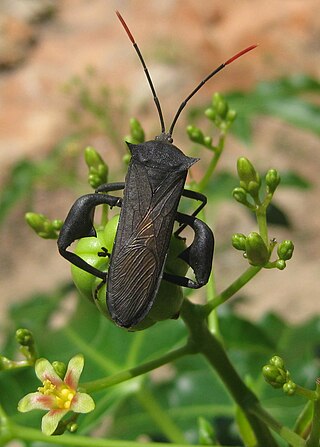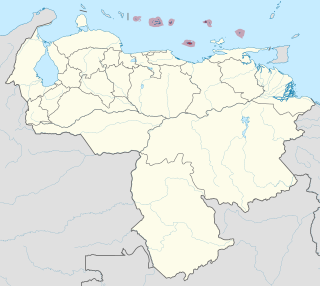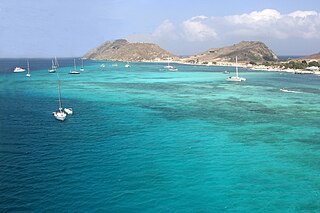
The Cheirogaleidae are the family of strepsirrhine primates containing the various dwarf and mouse lemurs. Like all other lemurs, cheirogaleids live exclusively on the island of Madagascar.

In Classical Greek mythology, Taygete was a nymph, one of the Pleiades according to the Bibliotheca (3.10.1) and a companion of Artemis, in her archaic role as potnia theron, "Mistress of the animals", with its likely roots in prehistory. Mount Taygetos in Laconia, dedicated to the goddess, was her haunt.

The pollen basket or corbicula is part of the tibia on the hind legs of the female of certain species of bees. They use the structure in harvesting pollen and carrying it to the nest or hive where it is used as food by the colony.

Coreidae is a large family of predominantly sap-sucking insects in the Hemipteran suborder Heteroptera. The name "Coreidae" derives from the genus Coreus, which derives from the Ancient Greek κόρις (kóris) meaning bedbug.
Sommer's Sulawesi rat is a species of rodent in the family Muridae from Sulawesi. It is the only species in the monotypic genus Sommeromys and was described by Musser & Durden in 2002.

The Federal Dependencies of Venezuela encompass most of Venezuela's offshore islands in the Caribbean Sea and the Gulf of Venezuela, excluding those islands that form the State of Nueva Esparta and some Caribbean coastal islands that are integrated with nearby states. These islands, with a total area of 342 square kilometres, are sparsely populated – according to the preliminary results of the 2011 Census only 2,155 people live there permanently, with another hundred from Margarita Island who live there seasonally to engage in fishing. Local government is officially under the authority of Central government in Caracas, although de facto power is often held by the heads of the sparse and somewhat isolated communities that decorate the territories.

The musky rat-kangaroo is a small marsupial found only in the rainforests of northeastern Australia. First described in the later 19th century, the only other species are known from fossil specimens. They are similar in appearance to potoroos and bettongs, but are not as closely related. Their omnivorous diet is known to include materials such as fruit and fungi, as well as small animals such as insects and other invertebrates. The local Aboriginal name for the species is durrgim yuri.

Utetheisa is a genus of tiger moths in the family Erebidae. The genus was first described by Jacob Hübner in 1819.

The Los Roques Archipelago is a federal dependency of Venezuela consisting of approximately 350 islands, cays, and islets in a total area of 40.61 square kilometers. The archipelago is located 128 kilometers (80 mi) directly north of the port of La Guaira, in the Caribbean Sea.

Platypezidae is a family of true flies of the superfamily Platypezoidea. The more than 250 species are found worldwide primarily in woodland habitats. A common name is flat-footed flies, but this is also used for the closely related Opetiidae which were included in the Platypezidae in former times.

The Megamerinidae are a family of flies (Diptera) with about 11 species in three genera. They are small and are marked by an elongated, basally constricted abdomen. The family has been variously placed in the past within the superfamilies Diopsoidea, Nerioidea and more recently in Opomyzoidea but the evolutionary relationships remain unclear.

The Glyphipterigidae are a family of small moths commonly known as sedge moths, as the larvae of many species feed on sedges and rushes. More than 500 species have been described in the family.
Catolesia is a genus of flowering plants in the family Asteraceae.
Hughesia is a genus of flowering plants in the family Asteraceae.
Lasiolaena is a genus of Brazilian flowering plants in the family Asteraceae.

Chaptalia is a genus of flowering plants in the family Asteraceae.
Richterago is a genus of Brazilian plants in the family Asteraceae.

Megastigmus is a genus of minute wasps. There are more than 134 described species, more than half of which undergo larval development within the seeds of trees and shrubs.
Richard Brinsley Hinds FRCS was a British naval surgeon, botanist and malacologist. He sailed on the 1835–42 voyage by HMS Sulphur to explore the Pacific Ocean, and edited the natural history reports of that expedition.
Sokolov's shrew is a species of mammal in the family Soricidae. It is endemic to Vietnam.












